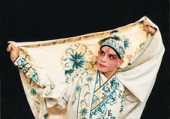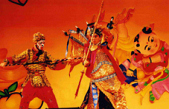
China Overview
- Population: 1.3 billion
- Currency: yuan
- Guinness World Records: most people painting each other's faces simultaneously in one location (13,413), largest bottle of cooking oil (containing 3212 litres), most couples hugging (3009 couples).
- Internet users: 135 million
- Milk beer: from Inner Mongolia, an alternative to the traditional mare's-milk wine.
- Squirrel fish: whole mandarin fish deep-fried and manipulated to resemble a squirrel.
- Number of chinese characters: over 56,000
Beijing Opera
Beijing Opera is the quintessence of China. The largest Chinese opera form is extolled as 'Oriental Opera'. Having a history of 160 years, it has created many 'firsts' in Chinese dramas: the abundance of repertoires, the number of artists, opera troupes and spectators. |
| How did the Beijing Opera develop? Beijing Opera incorporates many different forms of drama, mostly from the local drama 'Huiban' which was popular in South China during the 18th century. It is a scenic art that combines together music, performance, literature, aria, and face-painting. Certain rules are set up and regulations are standardized during many artists' long practice on stage. Different from |
|
regional plays, it is stricter on the variety of the workmanship. The combinationof virtual and reality - a special technique of expression, keeps it largely free from the restriction of time and space on stage performance. Beijing Opera has had many interesting names since it came into being, such as Jinghuang, Daxi, Pingju, Jingxi. | |
What are the four Means of Artistic Presentation? Beijing Opera presents dramatic plays and figures mainly by infusing four artistic methods: singing, dialogue, dancing and martial art. Singing is utilized to intensify the appeal of the art by all kinds of tones. Dialogue is the complement of singing which is full of musical and rhythm sensation. Dancing refers to the body movements requiring high performing skills. Martial art is the combination and transformation of traditional Chinese combat exercises with dances. |
 | What are the main roles in Beijing Opera Performance? Sheng: It's a common name of male characters and composed of Lao Sheng and Xiao Sheng. Lao Sheng refers to the middle-aged man with a beard who acts as the decency figure; for example, Zhugeliang in 'Empty City Scheme'. Xiao Sheng means young man without a beard. Zhangsheng in 'The Story of the West Room' is a representative of Xiao Sheng. |
Dan: The general name for female characters in Beijing Opera can be divided into Zhengdan, Huadan, Laodan, Wudan. Zhengdan is also called 'Qingyi', who mainly plays the part of the strong-minded middle-aged woman who behaves elegantly. Huadan refers to little girls who often live in the bottom of society. Laodan refers to the senior woman and Wudan indicates the female who is good at fighting. Jing: Painted face often refers to male characters with unique appearance or personality, such as Baozheng and Caocao. Besides, Chou is a comic role or villainous character or righteous person. The actor's nose is painted by a piece of white powder, making him or her easily recognizable. Chou refers to clowns, who are distinguished by a white patch on the nose. Usually, white patches of varying shapes and sizes are used to further distinguish roles of different character. These clowns are definitely not rascals, and most of the time they play roles of wit, alertness, and humor. It is these characters who keep the audience laughing, and improvise quips at the right moments to ease tension in some serious plays. | |
What are stage properties? Qimo is a general designation for all kinds of stage properties and simple settings used in Beijing Opera performances. It comes from the real life experience. For example, an actor can practice the scene of galloping the horse simply by using a horsewhip without riding a real horse on stage. A bridge is made up of two chairs standing on each side of a table. Storms are realized by performers dancing with umbrellas. The imaginary performance skills largely bring to performers the freedom to express more life scenes. |
Which style of music is used in Beijing Opera? The music of Beijing Opera is that of the "plate and cavity style".Its melody with harmonious rhythms is graceful and pleasing to the ears. The melody may be classified into two groups: "Xipi" and "erhong" with guiding pattern, original pattern, slow pattern, quick pattern, desultory pattern being their main patterns. The performance is accompanied by a tune played on wind instruments, percussion instruments and stringed instruments, the chief musical instruments being jinghu (a two-stringed bowed instrument with a high register), yueqin (a four-stringed plucked instrument with a full-moon-shaped sound box), Sanxian (a three-stringed plucked instrument), Suona horn, flute drum, big-gong, cymbals, small-gong, etc. |
| What are the costumes and facial make-ups? The costumes in Beijing Opera are graceful, magnificent, elegant and brilliant, and mostly are made in handicraft embroidery, which represents particular characteristics and specific importance to attract the audience's attention. It took the example of every-day clothing in ancient Chinese times as the foundation, imitating the dressing-style of the Ming Dynasty and later extracting the attire characteristic and style of the Qing Dynasty and the dressing of Baqi. After many artists' refinement, recapitulation, beautification and decoration, the appropriative clothing of a certain pattern was then |
|
formed and the shoptalk of Beijing Opera called it 'Xingtou'. Xingtou is the general term used for clothing for all kinds of roles, including long gowns, short clothes, armor, casque hats, boots and shoes, as well as assistant clothing or things attached to dressing. The types of facial make-ups in Beijing Opera are rich and various, depicting different characters and remarkable images, therefore they are highly appreciated. Moreover there are numerous fixed editions of facial make-up. The make-up that the Beijing Opera puts on the actor's face also has a special characteristic for displaying the character of the specific role. Using particular colors on the actor's face to symbolize their character and quality, role and destiny is not only the major characteristic of Beijing Opera, but also the key to understand the opera's plot. Simply speaking, the red painted-face represents allegiance and gallantry; The black painted-face is valor and wise; The blue and the green ones are the bold and courageous. | |
Who are the famous Beijing Opera Players? The theatrical or musical occupation was considered the lowest class in the society. Opera performance used to be a male dominated profession. There are many famous masters at performing Beijing Opera. Among them, the Four Famous Dans - Mei Lanfang, Cheng Yanqiu, Shang Xiaoyun and Xun Huisheng - are most well-known at home and abroad. They are experts in performing the role of Dan and each has his own artistic characteristic. Their wonderful performances are still appreciated by many audiences. For example, 'Farewell My Concubine' by Mei Lanfang, 'Injustice to Dou'e' by Cheng Yanqiu, 'Lady Zhaojun Going beyond the Great Wall' by Shang Xiaoyun and 'Matchmaker' by Xun Huisheng. |
 | What is the history of Beijing Opera? Beijing Opera originated from the middle period of the Qing Dynasty (1644-1911). In the 55th year reigned by the Emperor Qianlong (1790), the most famous four theatrical troupes in Anhui – Sanqing Troupe, Sixi Troupe, Chungong Troupe and Chun Troupe went to Beijing in succession to show their opera performance and then obtained the unprecedented success. |
Then, based on 'Anhui Opera', 'Han Opera', absorbing the essence of the local folk ditty like the 'Kun Opera', 'Yiyang Opera' and 'Shaanxi Opera' and also mixed with characteristics of Beijing dialect, Beijing Opera was formed. Although formed in Beijing, it is not the native-born but a melting opera. The Beijing Opera was officially formed after the 20th year of the Emperor Daoguang (1840). At that time, the formats of each kind of arias and the language of Beijing Opera initially came into being. New changes appeared in the Opera's role. A list of plays possessing the characteristics of the Beijing Opera and the first generation of the opera actors were also taken on. Beijing Opera contains the soul of Chinese national culture. Its unique charm inspires ethos of Chinese people. There is no doubt that it is really the treasure of Chinese culture. If you want to taste the real Beijing Opera, Liyuan Theatre in Beijing will be a good choice for you. | |
All Topics about China
- General-China-Introduction
- C2-Chinese-History
- Chinese-Religions
- Chinese-Food-and-Drink
- Chinese-Literature
- Chinese-Nationality
- Chinese-Architecture
- Chinese-Arts-and-Crafts
- Chinese-Language-and-Education
- Chinese-Medicine
- Chinese-Transportation
- Chinese-Festival
- Chinese-Astrology-and-Zodiac
- Chinese-Calendar
- Chinese-Traditional-Sports-&-Activities
- Chinese-Martial-Arts
HOTMost Popular Topics
Climate in China
Because of its size, China has great climatic diversity. Generally, the best time to visit China is during spring and autumn.
Chinese-Language-and-Education
Chinese is the most commonly used language in China, and one of the most commonly used languages in the world.
Chinese-Festival
China has many traditional festivals, including the Spring Festival, the Lantern Festival, the Dragon Boat Festival.
Chinese Chinese-Astrology-and-Zodiac
In the Chinese zodiac, twelve animals are used to denote the year of a person's birth: rat, ox, tiger, rabbit, dragon.
History of China
China, one of the world's most ancient civilizations, has a recorded history of nearly 4,000 years..









